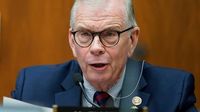On April 28, 2025, House Republicans unveiled a sweeping plan to overhaul the U.S. education system, particularly focusing on student loans and financial aid. The proposed legislation, known as the Student Success and Taxpayer Savings Plan, aims to reshape the financial landscape for students and families, with significant implications for how education is funded and accessed.
The 100-page bill, introduced by Rep. Tim Walberg, chair of the House Education and Workforce Committee, proposes to streamline student loan repayment options and eliminate certain federal loan programs. The plan is designed to cut federal spending by over $330 billion, all while attempting to hold colleges accountable for the debt burdens they impose on students.
One of the most notable aspects of the bill is its proposal to condense existing student loan repayment plans from multiple options to just two: a standard repayment plan with fixed monthly payments, and a new Repayment Assistance Plan. This latter option allows for loan cancellation after 360 qualifying payments, ensuring that borrowers who consistently pay their monthly dues will not see their balances increase due to accruing interest.
However, the bill also seeks to eliminate the most generous repayment plans available to borrowers, which many fear will lead to higher payments and less debt relief overall. Critics argue that this approach could exacerbate the already challenging landscape of student debt in the United States.
Additionally, the legislation proposes to eliminate federal direct PLUS loans for students starting their education on or after July 1, 2026. These loans, which allow parents and graduate students to borrow up to the full cost of attendance, have been criticized for their high interest rates and potential to contribute to unsustainable debt levels.
Walberg stated, "Bottom line, it’s time to fix this broken cycle that is costly to taxpayers and leaves students worse off than if they never went to college." He emphasized that the bill aims to strengthen accountability for students and taxpayers while simplifying the student loan process.
In addition to changes in loan repayment options, the bill would impose new borrowing caps for federal student loans. Undergraduates would be limited to borrowing $50,000, while graduate students would face a cap of $100,000. These limits are set to take effect on July 1, 2026, and are expected to shift some borrowing to private student loans, which typically offer fewer protections than federal options.
Consumer advocates have raised alarms about the potential consequences of these changes. Aissa Canchola Bañez, policy director at the Student Borrower Protection Center, criticized the bill, stating, "This is a return to the worst failures of the past: 30 years of traps, tricks, and broken promises, where only a handful of borrowers ever see relief."
Sameer Gadkaree, president and CEO of The Institute for College Access and Success, echoed these concerns, arguing that the GOP's proposal would severely restrict college access by slashing financial aid programs and eliminating basic consumer protections.
Another significant change proposed in the legislation involves the Pell Grant program, which provides critical funding to low-income students. The bill would increase the eligibility requirements for Pell Grants, now requiring students to enroll in a minimum of 30 hours each academic year, up from the current requirement of 12 hours per semester. This change could disproportionately affect community college students, who often juggle work and family responsibilities alongside their studies.
Furthermore, the bill aims to expand Pell Grant eligibility for short-term workforce training programs, allowing students in certain vocational training to qualify for funding. However, it would also remove access to Pell Grants for students enrolled in fewer than six credit hours, potentially leaving many part-time students without financial support.
As the House Committee on Education and the Workforce prepares to mark up the legislation, it is clear that the proposed changes are part of a broader Republican agenda to reshape education financing in the country. The bill is seen as a way to support President Donald Trump's tax cuts while addressing what Republicans characterize as a long-standing crisis in the student loan system.
The legislation is expected to face significant opposition from Democrats and advocacy groups, who argue that it will deepen the affordability crisis for families seeking higher education. Education Secretary Linda McMahon has indicated that the department is committed to ensuring that borrowers are supported in repaying their loans and that colleges are held accountable for the debt they impose on students.
As the political dynamics unfold, the future of the Student Success and Taxpayer Savings Plan remains uncertain. The House and Senate will need to reconcile their differing visions for education reform, with significant implications for millions of students across the country. The debate over these proposed changes will undoubtedly continue as lawmakers consider the best path forward for American higher education.





